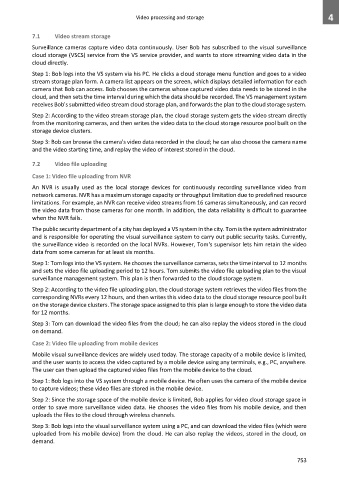Page 761 - Cloud computing: From paradigm to operation
P. 761
Video processing and storage 4
7.1 Video stream storage
Surveillance cameras capture video data continuously. User Bob has subscribed to the visual surveillance
cloud storage (VSCS) service from the VS service provider, and wants to store streaming video data in the
cloud directly.
Step 1: Bob logs into the VS system via his PC. He clicks a cloud storage menu function and goes to a video
stream storage plan form. A camera list appears on the screen, which displays detailed information for each
camera that Bob can access. Bob chooses the cameras whose captured video data needs to be stored in the
cloud, and then sets the time interval during which the data should be recorded. The VS management system
receives Bob's submitted video stream cloud storage plan, and forwards the plan to the cloud storage system.
Step 2: According to the video stream storage plan, the cloud storage system gets the video stream directly
from the monitoring cameras, and then writes the video data to the cloud storage resource pool built on the
storage device clusters.
Step 3: Bob can browse the camera's video data recorded in the cloud; he can also choose the camera name
and the video starting time, and replay the video of interest stored in the cloud.
7.2 Video file uploading
Case 1: Video file uploading from NVR
An NVR is usually used as the local storage devices for continuously recording surveillance video from
network cameras. NVR has a maximum storage capacity or throughput limitation due to predefined resource
limitations. For example, an NVR can receive video streams from 16 cameras simultaneously, and can record
the video data from those cameras for one month. In addition, the data reliability is difficult to guarantee
when the NVR fails.
The public security department of a city has deployed a VS system in the city. Tom is the system administrator
and is responsible for operating the visual surveillance system to carry out public security tasks. Currently,
the surveillance video is recorded on the local NVRs. However, Tom's supervisor lets him retain the video
data from some cameras for at least six months.
Step 1: Tom logs into the VS system. He chooses the surveillance cameras, sets the time interval to 12 months
and sets the video file uploading period to 12 hours. Tom submits the video file uploading plan to the visual
surveillance management system. This plan is then forwarded to the cloud storage system.
Step 2: According to the video file uploading plan, the cloud storage system retrieves the video files from the
corresponding NVRs every 12 hours, and then writes this video data to the cloud storage resource pool built
on the storage device clusters. The storage space assigned to this plan is large enough to store the video data
for 12 months.
Step 3: Tom can download the video files from the cloud; he can also replay the videos stored in the cloud
on demand.
Case 2: Video file uploading from mobile devices
Mobile visual surveillance devices are widely used today. The storage capacity of a mobile device is limited,
and the user wants to access the video captured by a mobile device using any terminals, e.g., PC, anywhere.
The user can then upload the captured video files from the mobile device to the cloud.
Step 1: Bob logs into the VS system through a mobile device. He often uses the camera of the mobile device
to capture videos; these video files are stored in the mobile device.
Step 2: Since the storage space of the mobile device is limited, Bob applies for video cloud storage space in
order to save more surveillance video data. He chooses the video files from his mobile device, and then
uploads the files to the cloud through wireless channels.
Step 3: Bob logs into the visual surveillance system using a PC, and can download the video files (which were
uploaded from his mobile device) from the cloud. He can also replay the videos, stored in the cloud, on
demand.
753

